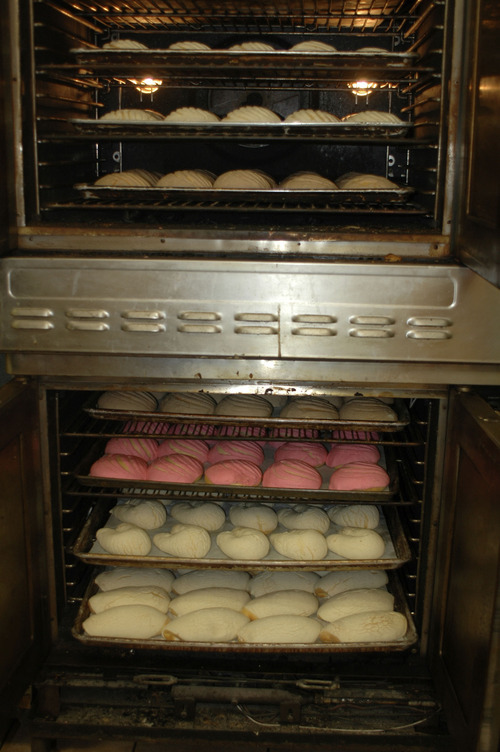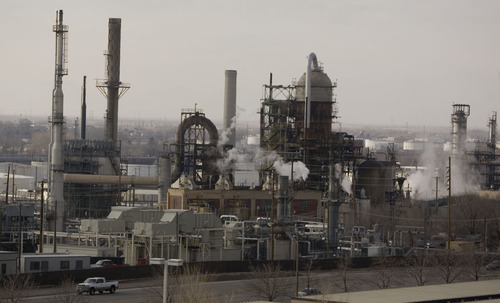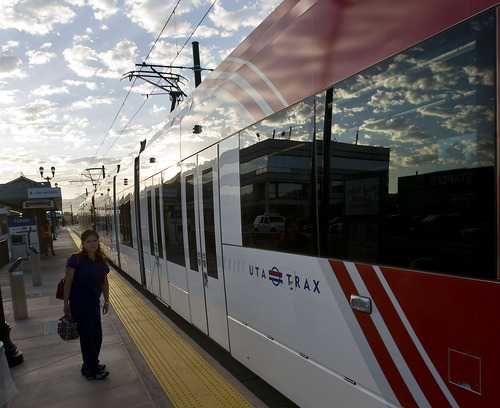This is an archived article that was published on sltrib.com in 2012, and information in the article may be outdated. It is provided only for personal research purposes and may not be reprinted.
It might seem silly to think that capturing yeasty vapors at bakeries could help clean up Utah's air.
The same might be said of using low-fume household chemicals, phasing out pilot lights or strategically slowing traffic on the interstate highways.
But pollution-cutting ideas like these were all on the table last week as Utahns brainstormed solutions for northern Utah's PM2.5 problem. As the state heads into the deadline for solutions, there are lots of ideas, but no easy answers.
"This will be a difficult challenge," said Bryce Bird, director of the Utah Division of Air Quality, at one of four meetings last week for clean-air activists, industry representatives and government officials sorting through pollution control ideas.
"This is what it takes to get there," he noted, pointing to the seemingly small yet crucial pollution solutions, "and we have to get there."
Controlling wintertime buildups of microscopic soot pollution is not optional, Bird explained. Like 31 other areas nationwide that are out of compliance with the Clean Air Act, Utah has until year's end to propose plans to reduce PM2.5.
Meanwhile, solutions are sure to affect virtually everyone in northern Utah, where mountain valley basins can trap pollution for days at a time — and sometimes for weeks.
No single change could cut pollution enough to bring northern Utah into compliance with the Clean Air Act by the 2014 deadline, nor even a 2019 extended deadline state regulators are expected to request. Cutting industrial emissions, getting cleaner-running cars and trucks on the road and reducing wood burning — all would fall short as stand-alone solutions.
Buck Swaney, a facilitator who led last week's discussions, noted that the obvious steps, such as programs to regulate wood burning and vehicle emissions in urban areas, already have been taken.
"All the fruit's pretty high in the tree now," he said at a Davis County forum.
The last of five stakeholder meetings is set for Monday in Utah County. In the weeks that follow, a team of DAQ engineers, scientists and regulation experts will try to weave the groups' suggestions into proposed regulations that will, in turn, go out to public comment sometime this summer.
Bound to annoy • No matter what is proposed, the cleanup plan is almost certain to annoy, inconvenience or offend. Some changes would mean paying for equipment updates — like smoke capture at restaurant meat grills — or a change in habits, like switching to new, low-fume paints at home.
Stakeholders who suggested going after industry learned two reasons why that is not likely to be the general-purpose solution.
First, clean-air laws have already forced most smokestack industrial plants to make costly and dramatic emissions cuts. And, second, they don't account for as much of the problem as vehicles, homes and other businesses.
DAQ estimates that power plants, refineries and Kennecott Utah Copper's smelters and other smokestack "point sources" are now responsible for about 19 percent of the PM2.5 pollution. Meanwhile, "mobile sources" like cars and trucks account for 47 percent and homes and businesses — "area sources" — make up 34 percent.
Under the state's plan, point sources must trim emissions another 5 percent. Even if the state asked for another 20 percent cut from these smokestacks, the pollution reductions won't be enough for the Salt Lake and Utah county areas to comply with U.S. Environmental Protection Agency standards.
For industry, any crackdown is potentially ominous. Stakeholders meeting in Box Elder County dubbed more pollution controls as "not business-friendly," lamenting that competitors in some states are avoiding clean-air mandates because the pollution blows away with the wind.
Paul Glauser of the Jack B. Parsons Cos. wondered aloud if the state should push back harder on EPA regulations.
"Maybe we need to do what Texas did," he suggested, "and tell them to go fly a kite."
While that idea may have some appeal, industry and state regulators have resisted the approach because if the state can't comply, the EPA would assume control over permitting and enforcement of the Clean Air Act — a result few desire.
A shared problem • Brian Shaffer, Box Elder Commission chairman, said solving the PM2.5 puzzle is everyone's problem, not just industry's. Jobs and the economy are at stake, said the commissioner, whose county and key industries sued to get taken out of the PM2.5 plan but failed.
"It's a huge team effort," Shaffer noted, "and we're all going to do our part."
In that spirit, the recent brainstorming included looking at the things homeowners, small businesses and ordinary Utahns can do to bring down PM2.5 levels.
Among the ideas for reducing area source pollution — along with controlling yeast vapors at large bakeries and capturing smoke at restaurant grills — are stepping up dust control at construction projects, promoting natural gas to cut nitrogen oxide emissions and requiring low-solvent paints and degreasers and chemical strippers throughout the PM2.5 trouble zone.
In homes, the DAQ team has suggested state prohibitions on wood burning on bad-air days in Tooele, Cache and Box Elder counties. Those regulations already are in place in Wasatch Front counties.
They have also considered limiting the volatile organic compound content in personal care products, household cleaners, insecticides, sealants, lawn and garden products. And they hope to encourage a phaseout of pilot lights for appliances like water heaters, gas fireplaces and stoves.
Cars and trucks make up the sector with the greatest potential for cuts, but many suspect it will be the toughest to tackle.
For instance, to get more people to use public transit might mean adopting free-fare days when pollution is high or lowering speed limits during high pollution periods. While both options might be doable, they traditionally lack political support.
Even the idea of implementing vehicle inspection and maintenance programs in Tooele, Box Elder and Cache counties rankles those who doubt their cars and trucks in rural areas can really make a big difference in pollution.
Said LuAnn Adams, a Box Elder County commissioner: "It's going to be truly difficult for us to come up with ideas." —
PM2.5 primer
The microscopic pollution made up partly of soot from engine and industrial combustion has to be reduced, under the Clean Air Act's health-based standards. Although the state has enlisted stakeholders from the community — including business, government and advocacy groups — to help make a PM2.5 reduction plan, the job hasn't been easy. The goal is to bring PM2.5 levels below 35 micrograms pollution per cubic meter of air within a few years.









